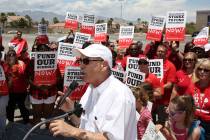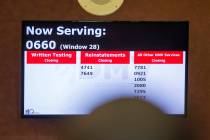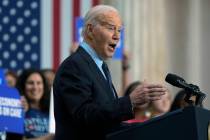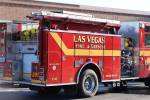Medical transport: Fire Department’s services too expensive
Today the Las Vegas City Council begins the public process of answering a critical fiscal and public safety question: Should the Fire Department significantly expand its paramedic operations or get out of running ambulances altogether?
An efficiency study completed to help answer that question will be presented to the council this afternoon. If the city is serious about curbing future budget growth, that study provides a pretty clear solution: get out.
The city currently uses a dual-response model for medical emergencies. A Fire Department rescue unit and a private-sector American Medical Response ambulance are dispatched to calls for help. About 80 percent of the time, AMR transports patients to area hospitals.
For its service, AMR is paid by patients and their insurers. Sometimes, the company isn't paid at all. Although the city collects fees from some of the patients transported by firefighters, city taxpayers cover the lion's share of the bill for every Fire Department response.
The model is good for patient outcomes - having at least four paramedics rush to the scene of every medical emergency is quite a luxury. But it's an inefficient use of resources because AMR and the Fire Department have two vastly different pay scales. City firefighters receive two to three times as much compensation as typical AMR paramedics.
That's not because they're two to three times better at the job - firefighters undergo the same training and certification as AMR paramedics, often under the guidance of AMR instructors. Rather, it's because city rescue squads are trained for other jobs as well, primarily fighting fires - and are paid exceptionally well for those skills, too.
Across the country, the delivery of health care is shifting toward cost efficiency. Nurses, nurse practitioners and physician assistants increasingly are seeing and treating people with minor ailments so highly paid doctors can focus on the sickest patients. Leaving medical transport in Las Vegas to the Fire Department would be akin to having a surgeon see patients with sinus infections - and bill at the surgical rate.
Indeed, the city study found that discontinuing the Fire Department's medical response would save the city between $14 million and $18 million per year, but kicking AMR out of the market and having firefighters take over all patient transport wouldn't generate enough fees to realize identical savings. The council must recognize the likelihood that expanding transport services would increase costs.
The study identified other inefficiencies within the Fire Department, from the way it deploys its ambulances to the overtime and staffing inflexibility created by collective bargaining - essentially, the city needs the firefighter union's permission to try to reach full efficiency and productivity. Do council members and management believe that task would be easier if they boosted the Fire Department's workload?
City firefighters do a good job. But some of their work is redundant and needlessly expensive to the public. And ultimately, the city doesn't have the experience or the technology to handle all patient transports, a job that AMR is doing capably right now. The council should focus any Fire Department reforms on saving money, not spending more of it.























